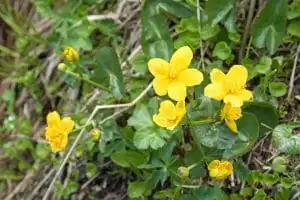Marsh marigold (caltha palustris) is a perennial herb found in North America’s wetlands, marshes, and alongside streams and lake beds. Also known as kingcup or cowslip, it is a member of the buttercup family and not a relative of the marigold flower, despite the name. Its pretty yellow flowers are among the first to bloom in spring, and although they make an attractive addition to your yard or garden, there are some reasons you may not want marsh marigold around.
Identifying Marsh Marigold
A native plant in North America, marsh marigold thrives in moist soil and produces flowers from early spring through early summer. Although it grows well in partial shade, marsh marigold flowers best in full sun. The shiny, bright yellow flowers are similar in appearance to buttercups but larger. They grow in clusters with glossy green leaves that are oval or heart shaped. The hollow branching stems reach anywhere from eight inches up to two feet tall.
Marsh Marigold Madness: Signs and Symptoms
Although these flowering plants are pretty in appearance, there are reasons to stay away from them. Marsh marigolds are often hard to eradicate once they find a home in your yard. And they reproduce very quickly, each one dispelling up to 200 seeds across a lawn or garden. These plants have hearty root systems and hold up well in inclement weather. Once established, marsh marigolds are here to stay.
Marsh marigold is mildly poisonous. In the past, it was used for medicinal or culinary reasons, but it must be thoroughly cooked to get rid of the toxicity. Be careful when handling marsh marigold, as it has been known to cause skin rashes. And be sure to keep the kids and pets away from it. Bees and other insects often seek out marsh marigolds for pollen and nectar. If you or a family member is allergic to bee stings, it’s not a good plant to have around.
Probably the biggest reason to avoid bringing marsh marigold into your yard is that it’s easy to mistake it for the invasive weed fig buttercup, also known as lesser celandine. This aggressive plant spreads fast and quickly competes with native plants, often crowding them out and taking over light, nutrient, and water sources. Both plants have similar yellow flowers and shiny green leaves, but there are also differences. And it’s important to distinguish between the two. Fig buttercup has tubers on its roots and bulblets on its stems, while marsh marigold does not. And while marsh marigold grows in clumps, fig buttercup forms a seemingly endless carpet and has leaves that are darker green.
Marsh Marigold Management
Once fig buttercup takes root, it is very difficult to get rid of it, and will quickly carpet your yard. Marsh marigold and fig buttercup are often mistaken for each other. To avoid an invasion it is best to steer clear of both.
Both plants require moist conditions to thrive, so keep your yard well maintained. Don’t overwater, aerate your lawn as necessary, and fix any drainage issues.
Removing marsh marigold from your yard after it has taken over is a tedious job. The extensive root systems are hard to eliminate completely and any remainder easily survives and reproduces. In order to successfully pull the plant from the ground, dig a wide area around the plant. Then remove all rhizomes and roots from the broader area.
For help differentiating between native plants and invasive weeds, contact Free Spray Lawn Care at 419-529-5296.



Comments (0)
Thanks for your comment!
Thanks for your feedback! Your comments have been successfully submitted! Please note, all comments require admin approval prior to display.
Error submitting comment!
There is a problem with your comment, please see below and try again.